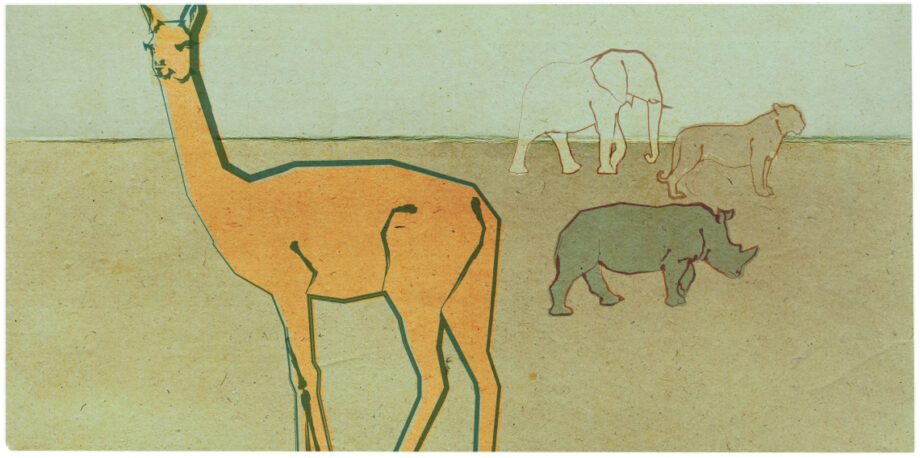March 4, 2014 — There is no simple solution to tackling illegal wildlife trade. But with the issue attracting unprecedented international attention as some of the world’s most iconic species reach a crisis point and links to large-scale organized crime and militant groups emerge, now is a good time to address the elephant in the room: the need to support the development of sustainable livelihoods for local communities as part of efforts to curb illegal activity.
Wildlife means more than just the elephants, rhinos and tigers that are usually the focus of illegal-trade attention. Across Africa and Asia, the wildlife trade also involves many other species that can and do form an important component of local economies (and enhance conservation) when people are allowed to use them in a sustainable way.
In Namibia, for example, a policy change in the mid-1990s that let local people use and benefit from wildlife on their land transformed attitudes toward conservation. Under the previous state control, poaching was common. Local people received no benefits from wildlife and saw it as competition for livestock grazing. Now communities increasingly see wildlife as an asset because of the benefits they reap from tourism and trophy hunting, and local social pressure against poaching has intensified.
Strategies to address illegal wildlife trade in iconic, endangered species should not harm opportunities for sustainable wildlife use and trade or inadvertently penalize the poor.
In the Andes, money from traded vicuña fiber has led some indigenous communities to share their grazing land with this threatened relative of the llama — and vicuña numbers have recovered from 10,000 in 1965 to 421,500 in 2010. Similarly, legal international trade in crocodile skins has been central to reducing illegal, unmanaged and unsustainable harvests.
Efforts to stem illegal wildlife trade must not cast all wildlife use in a bad light, but acknowledge and take advantage of the importance of working with local communities to encourage community-based and private sector management. The following strategies could help us move in that direction:
1. Recognize sustainable use as a crucial conservation incentive. Creating incentives through community-based resource management and locally controlled wildlife-based enterprises should be part of future interventions. At the very least, strategies to address illegal wildlife trade in iconic, endangered species should not harm opportunities for sustainable wildlife use and trade or inadvertently penalize the poor.
2. Enable evidence-driven dialogue and debate. The debate on illegal wildlife trade and on sustainable use as a conservation tool is highly polarized, particularly because it centers on endangered and iconic species. Some commentators oppose any consumptive use of wildlife, while others firmly believe in the “use it or lose it” philosophy of conservation. Equally, some believe that allowing legal trade in endangered species and their products exacerbates illegal trade, while others see legal trade as an integral means of offsetting and combating it. The evidence for each position is mixed. We need informed dialogue, not polarized positions.
3. Improve governance. Law enforcement strategies will only be effective if underlying governance structures, rule of law and accountability are present. Good governance is necessary to ensure organized crime does not subvert law enforcement and to help ensure justice and respect for human rights — in particular, to prevent broad-based law enforcement from harming poor and vulnerable people.
Long-term solutions to illegal wildlife trade require local support, where communities are sufficiently empowered and incentivized to sustainably manage and conserve wildlife. Addressing wildlife crime effectively demands we develop approaches that protect wildlife for poor people, not from them. ![]()
Editor’s note: The views expressed here are those of the author and not necessarily of Ensia. We present them to further discussion around important topics. We encourage you to respond with a comment below, following our commenting guidelines, which can be found here. In addition, you might consider submitting a Voices piece of your own. See Ensia’s “Contact” page for submission guidelines.
Ensia shares solutions-focused stories free of charge through our online magazine and partner media. That means audiences around the world have ready access to stories that can — and do — help them shape a better future. If you value our work, please show your support today.
Yes, I'll support Ensia!

However, while these strategies could have a positive impact upon conservation at specific locations, they would not be sufficient to temper international trade in endangered wildlife "products".
I have been working toward using carbon credits for rainforest preservation as the basis for protection of megafauna (especially highly endangered rhino) in Indonesia. The specific goal is to engage and fund local communities for both rainforest and fauna conservation.
Better "governance" at the national and regional level is needed, but the best efforts of Government and community to defend the rhino and other fauna won't change the economic incentive of the poachers. The defenses may be better, but the risk will remain until we impact directly and firmly on the traders and also, somehow, diminish the demand for wildlife "products".